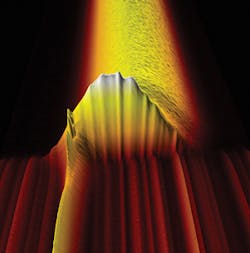Single-shot spectroscopy observes femtosecond pulses at 90 MHz frame rate

The shortest laser pulses are generated in titanium-doped sapphire (Ti:sapphire) oscillators through Kerr-lens mode-locking, a passive nonlinear process that favors the growth of short, intense transients. Group-velocity dispersion within the cavity is typically compensated with prism pairs or chirped mirrors, enabling ultrashort pulse duration values of less than 5 fs through soliton-like dynamics. But while the basic processes are understood and the pulses are ultimately stable, the start-up dynamics are highly nonrepetitive and stochastic, and—until now—impossible to observe. But researchers from the University of California at Los Angeles (UCLA) and the University of Göttingen (Göttingen, Germany) have now directly observed the spectral and temporal dynamics of this ultrashort pulse mode-locking transition on a single-shot basis over a record length of approximately 900,000 consecutive pulses using time-stretch dispersive Fourier transform (TS-DFT)—an instrument that maps single-shot spectra to the temporal domain that are then captured with a fast photodiode and a real-time oscilloscope.
Real-time experimental data charting ultrashort pulse formation shows a transition from fluctuating to stable operation as one out of the many fluctuations in the pulse grows sharply. Imprinting the optical spectrum of each pulse onto the temporal signal, the researchers are able to monitor the buildup of a chain of ultrashort pulses with constant broadband spectrum—a stable rainbow—from random initial fluctuations. By dispersing the laser radiation in a spool of optical fiber, single-shot spectra are recorded over a 10 ms period, with spectral information being obtained by a time-wavelength mapping process using the dispersive element of the TS-DFT instrument. The dispersive element separates the signal's constituent wavelengths in real time, allowing the spectrum to be measured with a real-time oscilloscope—one of the fastest electronic instruments available. Here, the researchers use this technique to follow the startup dynamics of the laser at its native repetition rate of 90 MHz—a speed far beyond the capabilities of conventional spectral measurement techniques. Reference: G. Herink et al., Nature Photon. online (March 14, 2016).
About the Author

Gail Overton
Senior Editor (2004-2020)
Gail has more than 30 years of engineering, marketing, product management, and editorial experience in the photonics and optical communications industry. Before joining the staff at Laser Focus World in 2004, she held many product management and product marketing roles in the fiber-optics industry, most notably at Hughes (El Segundo, CA), GTE Labs (Waltham, MA), Corning (Corning, NY), Photon Kinetics (Beaverton, OR), and Newport Corporation (Irvine, CA). During her marketing career, Gail published articles in WDM Solutions and Sensors magazine and traveled internationally to conduct product and sales training. Gail received her BS degree in physics, with an emphasis in optics, from San Diego State University in San Diego, CA in May 1986.